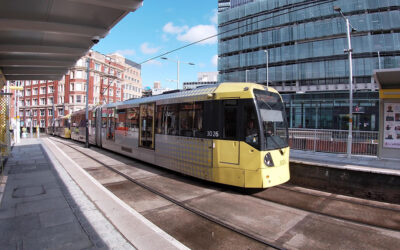More than £7m in funding has been approved for two active travel schemes that will improve journeys made by walking, wheeling and cycling in Radcliffe and Salford.
The Active Travel Fund investment was signed off by Greater Manchester’s Bee Network committee when it met earlier this month.
In Radcliffe, £2.89m will be spent on junction improvements at Spring Lane, next to the Metrolink Park and Ride. The scheme features a protected junction – which keeps pedestrians and cyclists safe by separating them from traffic – and a path alongside the new STAR Academy access road, connecting over the canal to the ‘banana path’.
The ‘banana path’ provides an off-road route from homes on the north side of Radcliffe to the new school and the Metrolink stop.
The junction improvements at Spring Lane are part of a wider, four-phase scheme planned to make it easier and safer for people to walk, wheel and cycle around Radcliffe town centre and its neighbouring areas.
In Salford, £4.32m will be invested in the Oldfield Road Corridor scheme, which will introduce segregated pedestrian and cycle tracks along the A5066 Oldfield Road Corridor between the A6 Chapel Street and A57 Regent Road.
This improvement to walking, wheeling and cycling along Oldfield Road will better connect Chapel Street and Regent Road, providing improved access to the public transport network and encouraging more people to use it.
A further £1.8m was approved to progress business cases for Trafford’s Carrington Sustainable Corridor and the Hindley Travel Hub project.
The infrastructure investments are all part of a joined-up plan to link the Bee Network public transport options with better walking, wheeling and cycling routes.
Dame Sarah Storey, Active Travel Commissioner for Greater Manchester said: “These two schemes will make a real difference in Radcliffe and Salford, making it safer and easier for people to walk, wheel or cycle along key routes to popular destinations.
“The new infrastructure to be installed near to Star Academy in Radcliffe will undoubtedly enable more pupils to travel actively to school, and once further works are complete, fully connect them to other destinations across the town centre.
“It’s also great to see funding approved for the fully segregated pedestrian and cycle tracks along Oldfield Road, a scheme that will provide people with a Bee Network standard active travel route, connecting to other cycle tracks, as well as providing better connections to public transport.”
Cllr Alan Quinn, cabinet member for the environment, climate change and operations at Bury Council, said: “This scheme has an important role in our ongoing regeneration of Radcliffe. It forms the entrance to the town’s new high school, it’s next to the town’s Metrolink stop, and it’s at a crossroad in the town’s walking and cycling network.
“But this is just the start – £9 million has been earmarked for Active Travel schemes in Radcliffe from the GM City Region Sustainable Transport Settlement.
“Future phases of work will include improved routes between the Metrolink stop and the new civic hub, improved connections between residential areas and the town centre, and generally make it safer and more attractive to walk, wheel or cycle into and around the town centre.”
Councillor Mike McCusker, Lead Member for Planning, Transport and Sustainable Development at Salford City Council said: “The Oldfield Road Corridor scheme is a significant investment into the city’s transport infrastructure.
“The project will encompass a range of new and innovative improvements that will benefit everyone by improving our connectivity, promoting more responsible and sustainable transport options and enhancing the safety and passenger experience of our residents and visitors to Salford”.
“The scheme is part of a Greater Manchester-wide programme to create the largest joined up system of walking and cycling routes in the UK to encourage cycling and walking and help take more cars off the road to ease congestion for everyone.”
These are the latest of a wide range of infrastructure investments funded to improve the integration, performance and resilience of the Bee Network, resulting in a better experience for those who use it.
The Bee Network is pivotal to delivering sustainable economic growth, increased productivity and the city region’s wider objectives, by connecting people with education, jobs and wider opportunities.
It also has a vital role to play in unlocking development, enabling housing growth, acting as a catalyst for regeneration, reducing carbon emissions and supporting social inclusion and active and healthy lifestyles.
The Radcliffe Town Centre Development Streets for All scheme is being delivered in the following four phases:
- Phase 1 – Spring Lane Junction Improvements.
- Phase 2 – Town Centre Links.
- Phase 3 – Victoria Street Links.
- Phase 4 – Southern Access.



